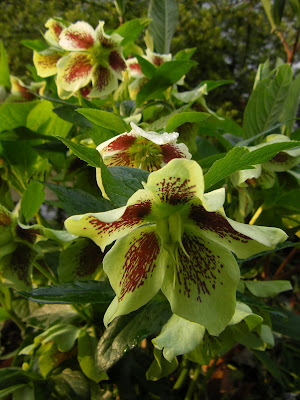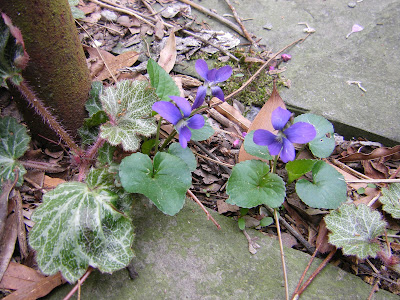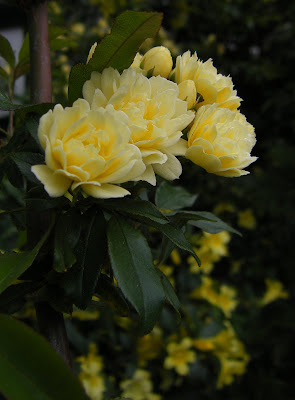I seem to be between seasons here. Winter is definitely over, but spring is reluctant to warm up - not that I am trying to rush things. As I mentioned in December's GBBD, spring is often very cool here as we are adjacent to the great weather moderators of the Chesapeake and the Atlantic. The air and land may be warm further inland, but when you live next to thousands of square miles of 50 degree water - spring starts off slow and lasts a wee bit longer, at least until the water temperature catches up with the air. Fortunately this can also keep us out of the danger zone when the rest of the state has late spring freezes.
My Hellebores (
Helleborus orientalis) are between seasons. Since this plant has had more than enough blogasphere exposure I'll spare you all of the pictures save one.
 Camellia japonica
Camellia japonica is good at bridging the span between late winter and early spring. Most of mine are just about through blooming except for my too latest varieties
'Cherries Jubilee' and
'Nuccio's Pearl'. 

While it is still too early to consider Hydrangea blooms, it is not too early to appreciate the incredible (unaltered) foliage color for
Hydrangea macrophylla 'Sun Goddess'.

These are the last two Narcissus to bloom in the garden, and I am sorry that I can't tell you there name. However I can tell you they did not cost me much.


This is the time that a lot of what are lumped together as "minor spring bulbs" in the catalogs start to bloom. These
Ipheion uniflorum have naturalized around the garden coming up where I did not plant them, but I'm OK with that as they will disappear underground soon.


Ditto the Wood Hyacinth (
Hyacinthoides hispanica).

Lesser Celandine (
Ranunclus ficaria) occupies the space in my garden between pretty spring flower and noxious weed. It also disappears when the heat arrives, otherwise I would be less tolerant of it.

This Violet (
Viola papilionacea) is certainly one of my worst weeds that just happens to have a nice flower. It is choking out things I want to spread like this Strawberry Geranium (
Saxifraga stolonifera). I have not had any luck getting rid of it accept for patiently pulling their little bulblets out of the soil when the ground is soft.

Here is another Violet, Confederate Violet (
Viola sororia priceana), that I planted on purpose after our friend Vicky (the ex DJ, ex Latin teacher, medical message maven) gave me a couple. It is said the name comes from the color of the Rebel uniform. I can only imagine that if the forces of the South went into battle wearing lavender uniforms, the war would have been over sooner. So far this plant has not gone marching across the garden.

By the large number of pups coming up underneath of it, I can tell that the Rice Paper Plant (
Tetrapanax papyrifera 'Steroidal Giant') will soon occupy the world between the weedy and the wanted. The Red Ruffles Azalea in the background is always my first to bloom. This was given to me by a former co-worker who moved back to Nova Scotia to grow plants in the cold. She pulled everything out of the ground she had planted in her Norfolk yard and gave it away to keep it from her landlord. Are you out there Nancy?
 Viburnum x juddi
Viburnum x juddi smells so sweet that it almost overcomes the odor of dog.


On the front porch the battle between the vines continues with no clear victor. The Lady Banks Rose (
Rosa banksiae 'Lutea') may be bigger ...

... but the Carolina Jessamine (
Gelsemium sempervirens) takes a lot of abuse, which seems to only make it stronger.

The winter was a little rough on the one of my Loropetalums (
Loropetalum chinense var. rubrum 'ZhuzhouFuschia'). However, it seems to be springing back and flowering profusely.

Speaking of profuse flowers, the Creeping Phlox (
Phlox subulata) has made a fine carpet by the front steps. Don't you know 14 years ago, an hour after we closed on this house, I was in the yard pulling plants out. This is one of the few survivors from the previous owner's intentions.

If you would like to see what is going on in other people's gardens, join the party at Garden Bloggers Bloom Day, hosted by
Carol at May Dreams Garden. While you are there please thank her for all her efforts.
 About three weekends ago we offered to take care of a puppy for my friend D.M. (the hand model) while she was out of town. D. fosters a lot of dogs and cats in her work with the Isle of Wight Humane Society, and in fact, our felines came from this organiztion. The puppy we temporarily fostered was a small Walker Hound whose name at the time was Roxanne. She fit in very well with our existing canine/feline/humanoid mix. She did not try to dominate the other dogs and was respectful to Loretta's (the weather dog) quirkiness and Patsy's considerable age. She showed little interest in the cats, which suited them just fine. She was more housebroken than not, and she only barked for good reasons. Most endearingly, she was so very affectionate and just wants to be a lap dog.
About three weekends ago we offered to take care of a puppy for my friend D.M. (the hand model) while she was out of town. D. fosters a lot of dogs and cats in her work with the Isle of Wight Humane Society, and in fact, our felines came from this organiztion. The puppy we temporarily fostered was a small Walker Hound whose name at the time was Roxanne. She fit in very well with our existing canine/feline/humanoid mix. She did not try to dominate the other dogs and was respectful to Loretta's (the weather dog) quirkiness and Patsy's considerable age. She showed little interest in the cats, which suited them just fine. She was more housebroken than not, and she only barked for good reasons. Most endearingly, she was so very affectionate and just wants to be a lap dog. As you may have guessed she is now officially ours, and we renamed her Penny (a.k.a. "Pencil Head") since one of the cats is Roscoe, and it would not do to have a Roxanne also. She continues to fit in well and knock wood, nothing has been destroyed, and we have had just one piddle in the house during the week that we have had her. So far she has been gentle to the garden, but we will keep an eye on that. I knew we would be getting another dog when Patsy goes, which I hope will not be soon, but she is 14. Getting 9 mo. old Penny now, seemed like the better choice than going through the brand new puppy process, plus she needed a home.
As you may have guessed she is now officially ours, and we renamed her Penny (a.k.a. "Pencil Head") since one of the cats is Roscoe, and it would not do to have a Roxanne also. She continues to fit in well and knock wood, nothing has been destroyed, and we have had just one piddle in the house during the week that we have had her. So far she has been gentle to the garden, but we will keep an eye on that. I knew we would be getting another dog when Patsy goes, which I hope will not be soon, but she is 14. Getting 9 mo. old Penny now, seemed like the better choice than going through the brand new puppy process, plus she needed a home.






























































